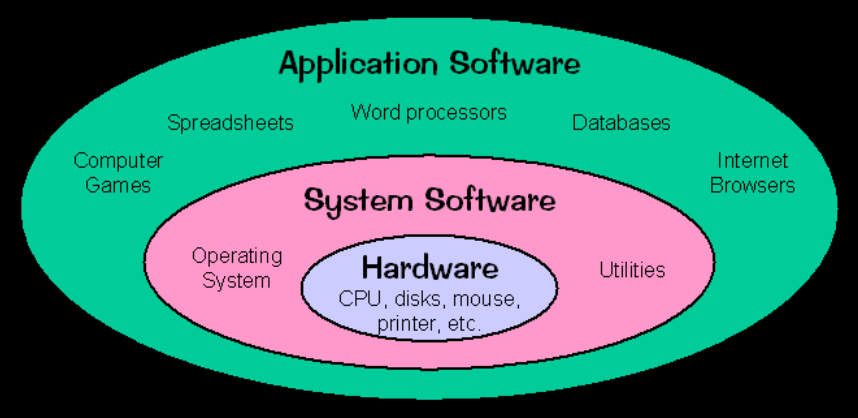01. Introduction to FOSS - Free and Open Source Software
01. Introduction to FOSS - Free and Open Source Software
IT1306-Free and Open Source Software for Personal Computing
Level I - Semester 1
1.1. Introduction to Major Software Classification
1.1.1. System Software
1.1.2. Application Software
1.2. Introduction to Free and Open-Source Software (FOSS)
Introduction to Major Software Classification
What is a Software?
• A set of instructions or programs instructing a computer
to do specific tasks.
• Software consists of the computer programs that govern the operations of the computer.
• Gives the computer the power to act as an intelligent machine.
• Without software, computers are dead hardware
• Software is normally classified into two components called
i. Application Software
ii. System Software
Application Software
• Application Software is a set of programs designed to carry
out operations for a specified purpose or task.
• Examples:
Packaged application (e.g. MS Office, spread sheets, etc ),
database management systems, systems developed according
to user requirements (bespoke) , accounting applications, web
browser, photo editor, etc.
System Software
• Application software cannot run without having system software.
• Hardware devices together with system software provide the infrastructure
to run/execute application software.
• acts as an interface between the hardware of the computer and the
application software
• System software communicates with hardware devices to coordinate
activities.
Example: Operating systems (Microsoft Windows, Linux, Unix, Mac OSX, DOS,
etc. ), Utility Software (scanners, file compression programs, data backup
programs etc.), Language Translators (Assembler, Compiler, Interpreter)
Application/System Software
System Software
1. Used for operating computer hardware.
2. Installed on the computer when
operating system is installed.
3. The user does not interact with system
software (it works in the background)
4. It provides a platform for running
application software.
Application Software
1.Used by user to perform specific task.
2.Installed according to user’s
requirements.
3.The user interacts with application
software.
4.Application software cannot run
without the presence of system
software.
Introduction to Free and Open-Source Software (FOSS)
What is Free(F) and Open(O) Source(S)
Software(S) - FOSS
• There are two major philosophies in the FOSS world
- • Free Software Foundation (FSF) philosophy and
- • Open-Source Initiative (OSI) philosophy.
• An umbrella term used for software that is considered both Free
software and open-source software.
Free Software Foundation (FSF) philosophy
• Free Software:
- • Computer software distributed under terms that allow users to run the software for any purpose as well as to study, change, and distribute it and any adapted versions
• Protecting four user freedoms:
- • The freedom to run a program, for any purpose;
- • The freedom to study how a program works and adapt it to a person’s needs. Access to the source code is a precondition for this;
- • The freedom to redistribute copies so that you can help your neighbor;
- • The freedom to improve a program and release your improvements to the public, so that the whole community benefits. Access to the source code is a precondition for this.
Open Source Initiative (OSI) philosophy
• Open Source Software:
- • A type of computer software in which source code is released under a license in which the copyright holder grants users the rights to study, change, and distribute the software to anyone and for any purpose.
- • Open-source software may be developed in a collaborative public manner.
• When programmers can read, redistribute, and modify the
source code for a piece of software, the software evolves.
• People improve it, people adapt it, people fix bugs.
FOSS Examples
• GNU/Linux Operating System
• Libre Office
• Open Office
• GIMP
• MySQL
• PHP
• Eclipse
FOSS – Pros & Cons
BENEFITS
• No cost or almost always cheaper than proprietary software.
• Security.
• Availability of source code.
• Open standards and vendor independence.
LIMITATIONS
• Lack of compatibility with proprietary systems.
• Lack of extensive documentation.
• Lack of support
• Uncertainty of the future updates
What is Proprietary Software
• Software that is solely owned by the individual or the
organization that developed it.
• The source code can only be modified by the individual or
organization who created it.
• The owner or publisher of the software holds intellectual
property rights of the source code exclusively.
• The internal structure of proprietary software is not exposed and
the restrictions are imposed upon the users by the End User
License Agreement (EULA)
Ref [1]: Difference Between Open Source and Proprietary Software | Difference
Between http://www.differencebetween.net/technology/difference-between-open-source-and-proprietary-software/#ixzz6CEeEGwZr
Proprietary Software Examples
• Windows
• macOS
• Adobe Flash Player
• Microsoft Office











